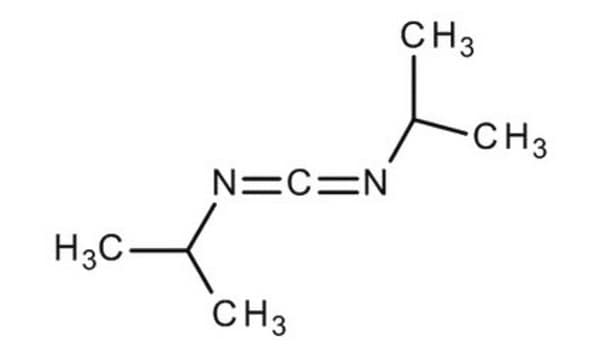901609
Diisopropylcarbodiimide solution
1 M in dichloromethane
Synonym(e):
Diisopropylmethanediimine
About This Item
Empfohlene Produkte
Form
liquid
Eignung der Reaktion
reaction type: Coupling Reactions
Konzentration
1 M in dichloromethane
Brechungsindex
n/D 1.4251
Dichte
1.2231
Anwendung(en)
peptide synthesis
InChI
1S/C7H14N2/c1-6(2)8-5-9-7(3)4/h6-7H,1-4H3
InChIKey
BDNKZNFMNDZQMI-UHFFFAOYSA-N
Suchen Sie nach ähnlichen Produkten? Aufrufen Leitfaden zum Produktvergleich
Allgemeine Beschreibung
Anwendung
- Alternative to dicyclohexylcarbodiimide in peptide synthesis.
- Coupling reagent for peptide syntheses.
- DIC (N,N′-Diisopropylcarbodiimide) has been used in combination with 1-hydroxy-7-azabenzotriazole (HOAt) for the coupling of amino acid with N-allylglycine to form N-allylpeptide.
Ähnliches Produkt
Signalwort
Danger
Gefahreneinstufungen
Acute Tox. 2 Inhalation - Carc. 2 - Eye Dam. 1 - Flam. Liq. 3 - Resp. Sens. 1 - Skin Irrit. 2 - Skin Sens. 1 - STOT SE 3
Zielorgane
Central nervous system
Lagerklassenschlüssel
3 - Flammable liquids
WGK
WGK 3
Flammpunkt (°F)
91.4 °F
Flammpunkt (°C)
33 °C
Analysenzertifikate (COA)
Suchen Sie nach Analysenzertifikate (COA), indem Sie die Lot-/Chargennummer des Produkts eingeben. Lot- und Chargennummern sind auf dem Produktetikett hinter den Wörtern ‘Lot’ oder ‘Batch’ (Lot oder Charge) zu finden.
Besitzen Sie dieses Produkt bereits?
In der Dokumentenbibliothek finden Sie die Dokumentation zu den Produkten, die Sie kürzlich erworben haben.
Unser Team von Wissenschaftlern verfügt über Erfahrung in allen Forschungsbereichen einschließlich Life Science, Materialwissenschaften, chemischer Synthese, Chromatographie, Analytik und vielen mehr..
Setzen Sie sich mit dem technischen Dienst in Verbindung.











